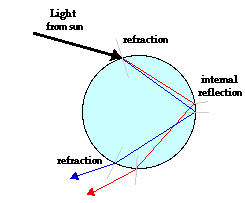Question #b56bd
1 Answer
Three must-happen for you to see a rainbow.
- The sun must be shining.
- It must be behind you, and
- There must be water droplets in the air in your front.
Sunlight shines into the water droplets. As a ray of light enters a droplet, it bends following laws of refraction. It is dispersed into its constituent colours at the point of interface. Then it is totally internally reflected off the back of the droplet. Thereafter the ray is refracted again as it emerges out of the droplet and travels towards observer's eyes as depicted in the figure below.

Looking at the details we have the following figure.
Depending on the angle of incidence
As such the light leaving the droplet is spread over a wide angle. It has a maximum intensity between angles
The complete system consisting of the sun's rays, the observer's eyes, and the spherical water droplet has an axial symmetry around the axis through the observer's eyes and parallel to the sun's rays.
This makes the rainbow circular because the set of all the droplets that have the correct angle between the eyes, the droplet, and the sun, lie on a cone with the eyes at its vertex. The base of the cone makes a circle at an angle of around
We must remember that rainbow does not exist at one particular location. Many rainbows are formed. As light from only some droplets reaches the observer's eye he sees only one.
